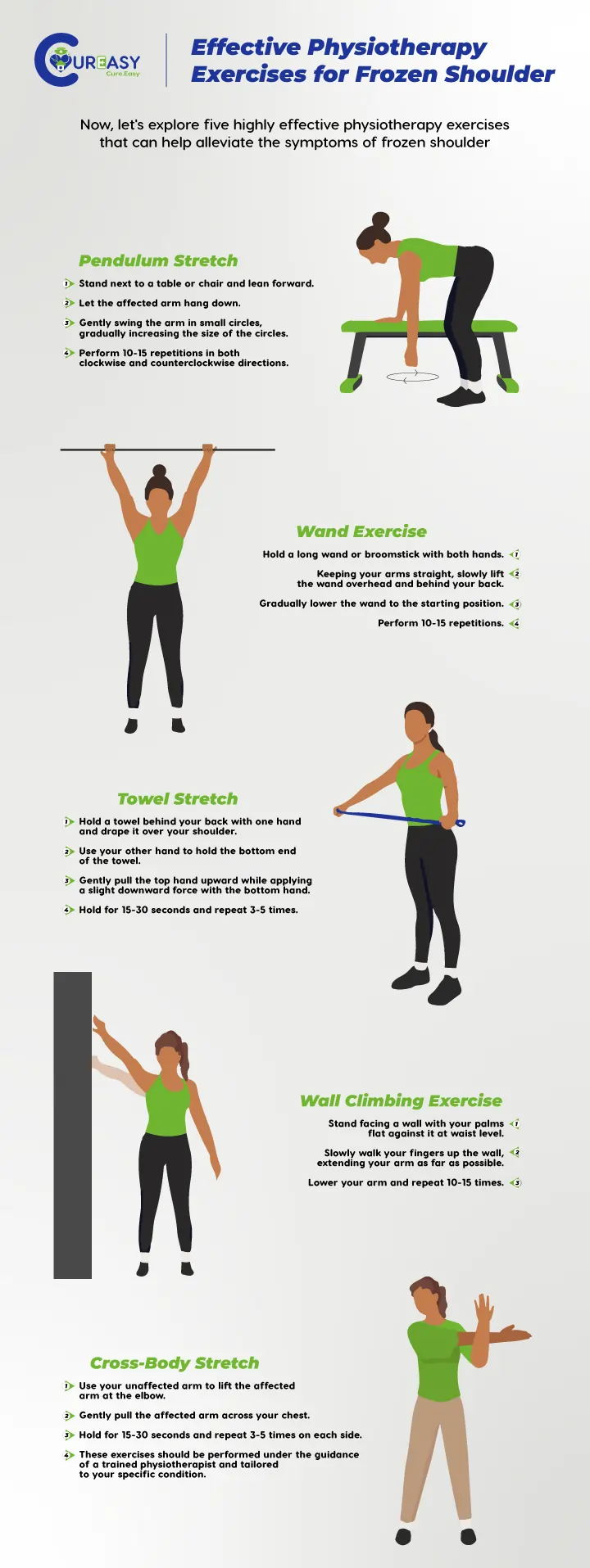Archives

Frozen shoulder, medically known as adhesive capsulitis, is a painful and debilitating condition that affects millions of people worldwide. The stiffness and restricted movement in the shoulder joint can significantly impact one’s daily life and quality of life. Fortunately, physiotherapy offers a beacon of hope for individuals suffering from frozen shoulder. In this comprehensive guide, we will delve into the causes of frozen shoulder, the benefits of physiotherapy, and explore five effective physiotherapy exercises to alleviate the condition. Additionally, we’ll discuss the advantages of receiving physiotherapy at home for this condition.
What Causes a Frozen Shoulder?
1. Inflammation and Thickening of the Shoulder Capsule
Frozen shoulder, known as adhesive capsulitis, occurs when the shoulder’s capsule of connective tissue undergoes inflammation and thickening. This thickening and inflammation, key aspects of frozen shoulder physiotherapy management, lead to stiffness and restricted movement in the shoulder joint. It’s crucial to address these issues with physiotherapy exercises tailored to gradually restore the shoulder’s range of motion and alleviate pain.
2. Lack of Use
Immobilization or restricted use of the shoulder, often following injury, surgery, or due to other medical conditions, is a significant contributor to frozen shoulder. Physio for frozen shoulder plays a pivotal role in reversing this condition by gradually encouraging mobility, preventing muscle atrophy, and breaking down adhesions that can form during periods of inactivity.3. Medical Conditions
Certain medical conditions such as diabetes, heart disease, and thyroid disorders increase the risk of developing frozen shoulder, emphasizing the need for frozen shoulder treatment physiotherapy. Physiotherapy interventions are essential in managing the condition in individuals with these underlying health issues. Tailored physiotherapy protocols can help alleviate the pain and stiffness associated with frozen shoulders in these patients while considering their specific medical needs.4. Age and Gender
The age group most commonly affected by frozen shoulder, typically between 40 and 60 years old, requires a specialized frozen shoulder physiotherapy protocol. Additionally, women are more prone to this condition. Physiotherapy exercises within the frozen shoulder physiotherapy protocol should be adapted to these demographics, taking into account age-related changes and hormonal influences. This personalized approach is essential to effectively address the unique needs of each patient in their frozen shoulder management journey.
Benefits of Physiotherapy for Frozen Shoulder
1. Pain Relief:
Physiotherapists employ various techniques to alleviate the pain associated with frozen shoulder. Manual therapy, one of the primary methods, involves hands-on techniques to manipulate and mobilize the shoulder joint and surrounding tissues. This approach aims to reduce muscle tension, improve blood circulation, and alleviate pain. Hot/cold therapy, another valuable tool, uses temperature-based treatments to manage pain. Heat therapy relaxes muscles and increases blood flow, while cold therapy reduces inflammation and numbs the affected area. Additionally, ultrasound therapy uses high-frequency sound waves to penetrate deep into the tissues, promoting healing and pain relief. Combined, these methods offer a multi-faceted approach to managing pain effectively and improving the patient’s comfort.2. Improved Range of Motion:
Frozen shoulder is characterized by the progressive loss of range of motion in the shoulder joint. Physiotherapy is instrumental in addressing this issue through targeted stretching exercises. These exercises are designed to gradually and safely stretch the stiffened shoulder capsule and surrounding tissues, restoring the shoulder’s full range of motion. As patients consistently perform these exercises under the guidance of a physiotherapist, they experience increased flexibility and a reduction in stiffness. Ultimately, this results in improved mobility, enabling individuals to regain their ability to perform daily tasks and activities without discomfort.3. Strengthening Muscles:
Strengthening exercises play a pivotal role in frozen shoulder rehabilitation. Physiotherapy focuses on rebuilding the muscles around the shoulder joint that may have weakened due to disuse or pain avoidance. By engaging in specific exercises that target these muscle groups, patients can regain strength and functionality. These strengthened muscles provide essential stability and support to the shoulder joint, reducing the risk of re-injury or complications. As the muscles grow stronger, patients experience improved control over their shoulder movements, enhancing overall shoulder function.4. Personalized Treatment Plans:
A hallmark of physiotherapy for frozen shoulder is the creation of personalized treatment plans. Each patient’s condition and progress are unique, necessitating a tailored approach. Physiotherapists conduct thorough assessments to understand the individual’s specific challenges, including the extent of pain, stiffness, and muscle weakness. Based on this assessment, they craft a treatment plan that includes a carefully selected combination of exercises, manual therapy techniques, and modalities such as ultrasound or electrical stimulation. Regular monitoring and adjustment of the treatment plan ensure that the therapy remains aligned with the patient’s evolving needs and progress, maximizing the effectiveness of the intervention.5. Non-Invasive Approach:
Physiotherapy offers a non-invasive and conservative approach to managing frozen shoulder. Unlike surgical interventions, physiotherapy does not involve incisions, anesthesia, or the associated risks and recovery periods. Similarly, it is a drug-free method, avoiding potential side effects or dependency issues that can come with pharmaceutical pain management. This non-invasive approach aligns with the principles of holistic and patient-centered care, focusing on addressing the root causes of frozen shoulder rather than merely alleviating symptoms. It empowers individuals to actively participate in their recovery journey and promotes a sustainable path to healing, emphasizing overall well-being and improved quality of life.
Five Effective Physiotherapy Exercises for Frozen Shoulder
Pendulum Stretch:
- Stand next to a table or chair and lean forward.
- Let the affected arm hang down.
- Gently swing the arm in small circles, gradually increasing the size of the circles.
- Perform 10-15 repetitions in both clockwise and counterclockwise directions.
Wand Exercise:
- Hold a long wand or broomstick with both hands.
- Keeping your arms straight, slowly lift the wand overhead and behind your back.
- Gradually lower the wand to the starting position.
- Perform 10-15 repetitions.
Towel Stretch:
- Hold a towel behind your back with one hand and drape it over your shoulder.
- Use your other hand to hold the bottom end of the towel.
- Gently pull the top hand upward while applying a slight downward force with the bottom hand.
- Hold for 15-30 seconds and repeat 3-5 times.
Wall Climbing Exercise:
- Stand facing a wall with your palms flat against it at waist level.
- Slowly walk your fingers up the wall, extending your arm as far as possible.
- Lower your arm and repeat 10-15 times.
Cross-Body Stretch:
- Use your unaffected arm to lift the affected arm at the elbow.
- Gently pull the affected arm across your chest.
- Hold for 15-30 seconds and repeat 3-5 times on each side.
- These exercises should be performed under the guidance of a trained physiotherapist and tailored to your specific condition.
Benefits of Having Physiotherapy at Home for Frozen Shoulder
Receiving physiotherapy at home offers several advantages for individuals with frozen shoulder:
Convenience:
Home-based physiotherapy eliminates the need for travel, making it more convenient, especially for those with limited mobility.
Personalized Care:
Physiotherapists can assess your home environment and suggest modifications to enhance your recovery.Comfort:
Being in a familiar environment can reduce anxiety and discomfort during therapy sessions.Consistency:
Home-based physiotherapy ensures that you can stick to your treatment plan consistently.
Family Involvement:
Loved ones can actively participate in your therapy, providing moral support and encouragement.Other Services
Thyroid test at home
Error: Contact form not found.
You might also like
The Diagnostic Value of CT Scans
Lab test at Home Food Intolerance Doctor at Home Physio
The Vital Role of Vaccinations: Essential for All Ages
Lab test at Home Food Intolerance Doctor at Home Physio
Breastfeeding Awareness Week: Simple Tips for New Moms
Lab test at Home Food Intolerance Doctor at Home Physio

